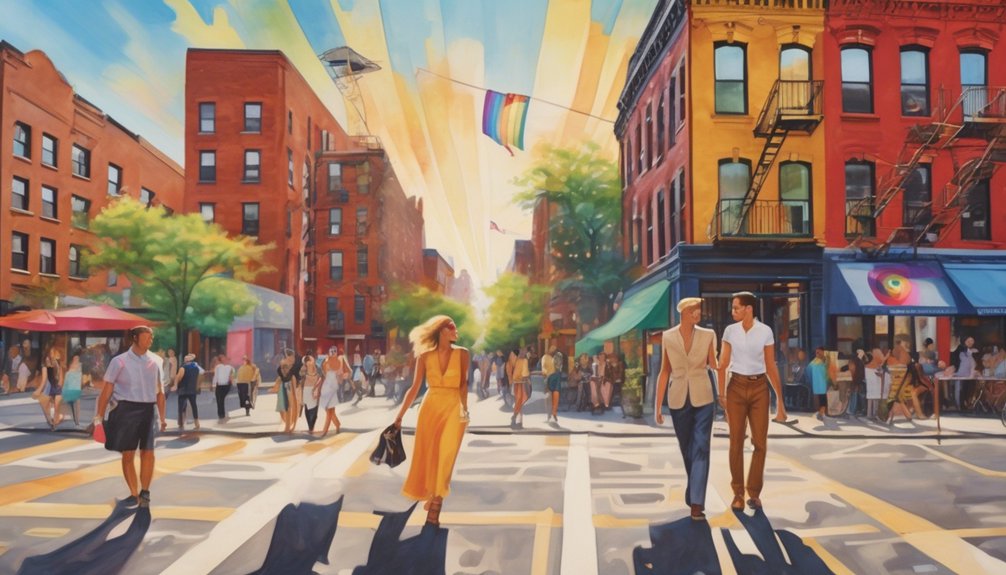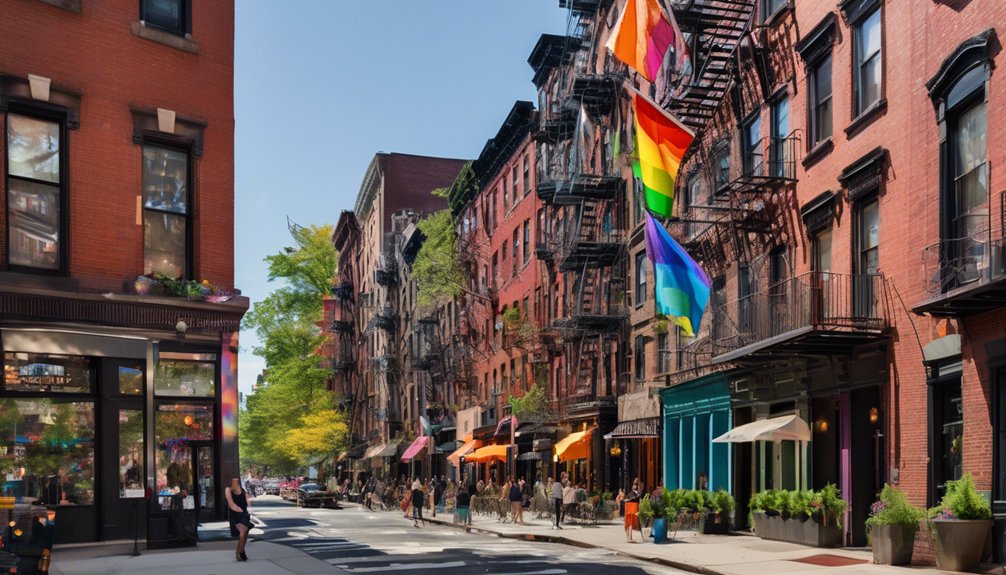The Gentrification of a Queer Paradise: A West Village Story


Table of Contents
ToggleImagine walking through a vibrant tapestry woven with decades of queer history, only to find its threads slowly unraveling under the weight of soaring rents and luxury high-rises. In the West Village, a neighborhood once celebrated as a sanctuary for LGBTQ+ culture and activism, change is both inevitable and unsettling. You’ll soon uncover how this transformation challenges not just buildings, but the very identity of a community fighting to keep its spirit alive.
Although the West Village’s vibrant queer scene is often associated with the Stonewall Riots of 1969, its roots run much deeper. You’ll find that this neighborhood has long served as the heart of LGBTQ+ history, offering a safe haven for the queer community well before Stonewall. From the early 20th century, artists and writers flocked here, shaping queer cultural spaces that fueled gay nightlife. Iconic spots like Julius’ Bar became key meeting points, and the Village’s role in LGBTQ+ activism grew as it hosted some of the first organized protests demanding rights. As you explore this history, you realize how vital historic preservation is in maintaining the stories embedded in these streets, especially amid pressures like gentrification, which threaten to erase this rich legacy.

When you walk through the West Village today, you’ll notice how sleek new buildings and luxury storefronts have reshaped the neighborhood’s landscape, but this transformation hasn’t come without cost. Gentrification and urban development have triggered significant neighborhood change, impacting the heart of LGBTQ+ spaces. Rising rents and luxury housing threaten displacement, pushing out long-standing residents and altering demographics. The community impact is profound:
These changes challenge the West Village’s identity as a queer paradise, raising urgent questions about who the neighborhood truly serves amid ongoing gentrification pressures.

As gentrification reshapes the West Village, preservation efforts have become a lifeline for its queer history and culture. You witness community resistance rallying to safeguard LGBTQ+ sites from erasure, as advocacy groups like the NYC LGBT Historic Sites Project document and defend these landmarks. Landmark designations and street namings, such as Sylvia Rivera Way, symbolize historic preservation victories amid relentless development pressures. Yet, the demolition of iconic venues like Paradise Garage reveals ongoing struggles. Federal policies aiming to erase trans identities intensify this fight, making local activism essential. With leaders like Councilman Erik Bottcher championing protections, you see the community’s determination to resist cultural erasure and honor the West Village’s rich queer history despite gentrification’s relentless advance.
The fight to preserve the West Village’s queer heritage isn’t just about landmarks and policies—it’s lived through the voices of those who’ve called this neighborhood home for decades. Longtime residents and activists witness gentrification eroding queer spaces and reshaping neighborhood identity, fueling their commitment to community preservation. You hear their stories in:
These voices embody resident activism, standing firm against forces that threaten the West Village’s historic community fabric.
Though gentrification continues to reshape the West Village, you can still find fierce determination among activists and residents working to protect its queer identity. The neighborhood’s LGBTQ+ history faces threats from demographic shifts and new developments, but preservation efforts push back. Landmark designations and community activism aim to safeguard historic sites, ensuring the queer cultural legacy endures despite neighborhood change. You witness a battle to balance growth with honoring a birthplace of LGBTQ+ rights.
| Challenge | Response |
|---|---|
| Gentrification pressure | Landmark designation |
| Demographic shifts | Community activism |
| Loss of historic sites | NYC LGBT Historic Sites Project |
| Risk to queer identity | Street renamings & preservation |
The future hinges on your support for preserving West Village’s vibrant queer identity.
You’ll find West Village became a hub for LGBTQ+ artists and writers by embracing its historic landmarks and vibrant local art scene. Community centers and literary salons offered safe spaces, while underground clubs and cultural festivals fueled creativity. Neighborhood murals and queer bookstores enriched the area’s identity. Activist movements thrived here, commemorated by historic plaques, making the neighborhood a nurturing ground where queer culture and artistic expression blossomed powerfully.
You’ll find the West Village at the heart of the Stonewall Riots, a catalyst for LGBTQ+ advocacy and community activism. This historic landmark sparked grassroots movements that reshaped neighborhood identity and fueled social justice efforts. As urban development threatened architectural changes and local businesses, the community fought for cultural preservation. The riots didn’t just erupt—they ignited a powerful resistance, transforming the West Village into a symbol of courage and resilience for generations.
Yes, you’ll find vibrant annual LGBTQ+ events in West Village, especially during Pride Month. You can join Pride Parades and Pride Walks that celebrate community and history. If you’re into arts, the Queer Art Fair and LGBTQ Film Festival showcase incredible talent. Don’t miss Drag Brunches for fun, or the LGBTQ Book Fair and Queer Music Night for culture. The LGBTQ Heritage Tour offers deep insights, making Pride Month Celebrations truly unforgettable.
Experiencing West Village’s queer history is like peeling back layers of a vibrant mural—rich with stories. You should visit historical landmarks and community spaces, join heritage tours, and investigate LGBTQ+ archives to understand intersectional identities. Engage with local activism and public memorials, and appreciate artistic expressions that preserve culture. Listening to oral histories honors lived experiences, helping you respectfully connect with the neighborhood’s enduring spirit and cultural preservation efforts.
You face displacement effects as rising rents shrink affordable housing, forcing many LGBTQ+ youth out of the neighborhood. This fuels community loss and cultural erasure, eroding the safe spaces that once nurtured your identity. Economic barriers and access issues deepen social isolation, while generational divides complicate understanding. Safety concerns grow as familiar support networks vanish, leaving you to navigate identity challenges amid the shifting landscape, struggling to find belonging in a once-thriving queer epoch.
You stand at a crossroads where history’s roots twist beneath shiny new sidewalks, reminding you that the West Village is more than bricks and mortar—it’s a garden nurtured by queer hands. As luxury towers rise like invasive vines, your choice is clear: protect this vibrant bloom or watch it wither. The fight isn’t just about space; it’s about preserving a living legacy, so future generations can still find shelter in this queer paradise.
 News and AdvocacyNovember 14, 2025Rainbow Victories: 2025’s Most Pro-LGBTQ+ States Revealed
News and AdvocacyNovember 14, 2025Rainbow Victories: 2025’s Most Pro-LGBTQ+ States Revealed News and AdvocacyNovember 14, 2025Transgender Sanctuary States: Protecting Rights, Providing Hope
News and AdvocacyNovember 14, 2025Transgender Sanctuary States: Protecting Rights, Providing Hope Featured PostsNovember 13, 2025When Restroom Policing Backfires: The Hotel That Went Too Far
Featured PostsNovember 13, 2025When Restroom Policing Backfires: The Hotel That Went Too Far Featured PostsNovember 13, 2025Sex, Safety, and Seduction: A Trans Girl’s Guide to Hookups
Featured PostsNovember 13, 2025Sex, Safety, and Seduction: A Trans Girl’s Guide to Hookups